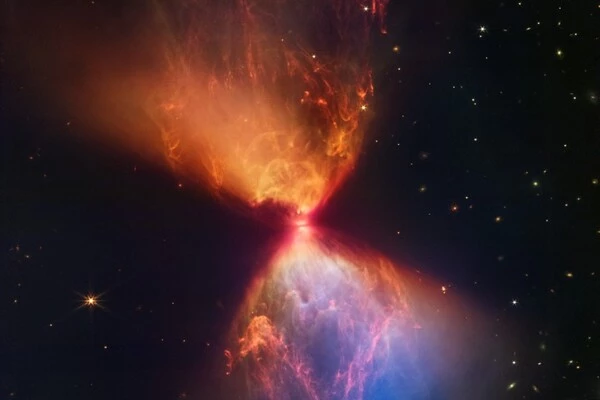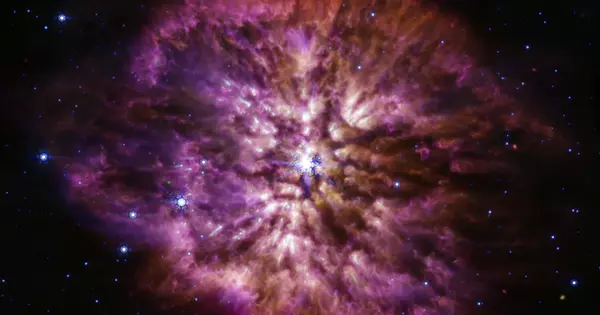Gravitational waves are ripples in spacetime created by the acceleration of enormous objects such as black holes or neutron stars during severe events such as mergers or supernova explosions. These occurrences generate enormous amounts of energy in the form of gravitational waves.
Although astrophysicists should theoretically be able to detect gravitational waves from a single, non-binary source, these elusive signals have yet to be discovered. Researchers now propose looking at a new, unexpected, and completely unknown location: the tumultuous, energetic cocoons of material that encircle dying big stars. Now, researchers from Northwestern University propose looking at a new, unexpected, and completely uncharted location: the tumultuous, energetic cocoons of material that encircle dying big stars.
For the first time, the researchers employed cutting-edge simulations to demonstrate that these cocoons can release gravitational waves. Moreover, unlike gamma-ray burst jets, gravitational waves from cocoons should be detected by the Laser Interferometer Gravitational-Wave Observatory (LIGO).
Our study is a call to action for the community to look at cocoons as a source of gravitational waves. We also know that cocoons emit electromagnetic radiation, suggesting that they could be multi-messenger events. We could learn more about what happens inside stars, the nature of jets, and their predominance in stellar explosions by studying them.
Ore Gottlieb
“As of today, LIGO has only detected gravitational waves from binary systems, but one day it will detect the first non-binary source of gravitational waves,” said Ore Gottlieb, the study’s lead author at Northwestern. “One of the first places we should look for this type of source is cocoons.”
Gottlieb will share these findings during a virtual news briefing at the American Astronomical Society’s 242nd conference. The talk “Jetted and turbulent stellar deaths: New LIGO-detectable sources of gravitational waves” will be held on Monday, June 5, as part of a session titled “Discoveries in Distant Galaxies.”
Gottlieb works at Northwestern University’s Centre for Interdisciplinary Exploration and Research in Astrophysics (CIERA). Professors Vicky Kalogera and Alexander Tchekovskoy of Northwestern, postdoctoral fellows Sharan Banagiri and Jonatan Jacquemin-Ide, and graduate student Nick Kaaz are among the study’s co-authors.

New source was ‘impossible to ignore’
To conduct the study, Gottlieb and his collaborators used new state-of-the-art simulations to model the collapse of a massive star. When massive stars collapse into black holes, they may create powerful outflows (or jets) of particles traveling close to the speed of light. Gottlieb’s simulations modeled this process — from the time the star collapses into a black hole until the jet escapes. Initially, he wanted to see whether or not the accretion disk that forms around a black hole could emit detectable gravitational waves. But something unexpected kept emerging from his data.
“When I calculated gravitational waves from the black hole’s vicinity, I discovered another source disrupting my calculations — the cocoon,” Gottlieb explained. “I tried to disregard it. But it was impossible for me to ignore. Then I realized the cocoon was a fascinating source of gravitational waves.”
When jets collide with the dying star’s collapsing layers, a bubble, or “cocoon,” forms around the jet. Cocoons are turbulent environments where hot gases and debris mix at random and spread outward from the jet. Gottlieb noted that as the energy bubble accelerates from the jet, it perturbs space-time, causing a ripple of gravitational waves.
“A jet starts deep inside of a star and then drills its way out to escape,” Gottlieb said. “It’s like when you drill a hole into a wall. The spinning drill bit hits the wall and debris spills out of the wall. The drill bit gives that material energy. Similarly, the jet punches through the star, causing the star’s material to heat up and spill out. This debris forms the hot layers of a cocoon.”
Call to action to look at cocoons
If cocoons do emit gravity waves, Gottlieb believes LIGO will be able to detect them in future runs. Traditionally, researchers have looked for single-source gravitational waves from gamma-ray bursts or supernovae, but astrophysicists doubt that LIGO will detect them.
“Both jets and supernovae are very energetic explosions,” Gottlieb explains. “However, gravitational waves can only be detected in higher frequency, asymmetrical explosions.” Because supernovae are spherical and symmetrical, spherical explosions do not disrupt the star’s balanced mass distribution and so do not release gravitational waves. Because gamma-ray bursts last dozens of seconds, their frequency is very low – lower than the frequency spectrum to which LIGO is sensitive.”
Instead, Gottlieb suggests that astrophysicists focus on cocoons, which are both asymmetrical and very energetic.
“Our study is a call to action for the community to look at cocoons as a source of gravitational waves,” he explained. “We also know that cocoons emit electromagnetic radiation, suggesting that they could be multi-messenger events. We could learn more about what happens inside stars, the nature of jets, and their predominance in stellar explosions by studying them.”





